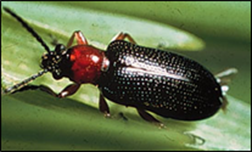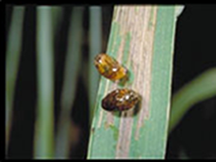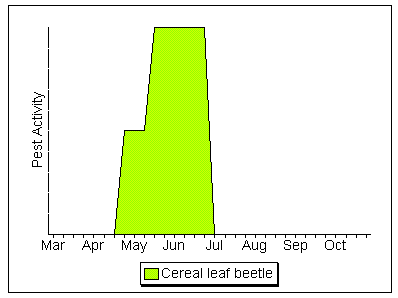Cereal Leaf Beetle in Wheat
Cereal Leaf Beetle
Description

Adult Cereal Leaf Beetle
Overwintering adult cereal leaf beetles can be found in Kentucky small grain fields from early April until mid-May. Their eggs are laid from mid-April until late May, and larvae occur from late April through mid-June. Cereal leaf beetle adults are shiny black beetles with red legs and thorax, approximately 1/2 inch long.
The larvae are pale yellow and soft bodied. They "glue" pieces of trash and leaves on their backs as camouflage and may look like bird droppings.
Damage
The adults and larva tear out long narrow strips of tissue between the leaf veins. This feeding pattern leaves long whitish scars on the leaves

Cereal Leaf Beetle Larvae
Photos - University of Kentucky
Dept. of Entomology
.
Cereal Leaf Beetle Activity

Please note: These dates are approximations only. This calendar was constructed using data from Kentucky, USA. These dates may not apply in your area. You may wish to contact your county extension agent or agricultural consultant for information tailored to your locality.
IPM Techniques and Scouting
- Cereal leaf beetles are the food source for many parasites and predators. The eggs are eaten by lady beetles and several wasp parasites prey on the larvae. Also, a fungal disease may reduce the population. As a result of the presence of these natural enemies, the presence of cereal leaf beetles in a field does not necessarily mean that they will have an economic impact.
- The number of sites you need to examine in a field is based on the size of the field.
- For High Management Strategy, begin scouting at GS7 (two nodes present).
For Low to Moderate Management Strategy, begin scouting by at least GS8 (flag) and continue through GS10.5 (flowering). - At each site check ten stems for larval and adult cereal leaf beetles.
- Calculate and record the average number per stem.
- High Management Strategy Threshold for egg/larval counts: Treat if you find any combination of 25 or more eggs and/or larvae per 100 tillers (i.e., an average of 1 per every 4 tillers or 0.25 per tiller).
Low to Moderate Management Strategy Threshold: Treat if you find an average of 0.5 larva and/or adult per head-bearing stem.
References and Additional Information
- IPM-4 Kentucky IPM Manual for Small Grains
- Entfact-107 Cereal Leaf Beetle in Kentucky Wheat


